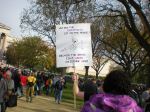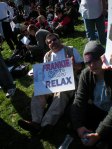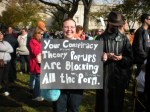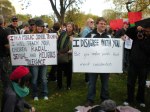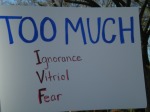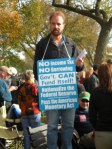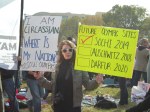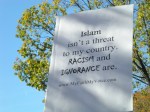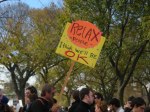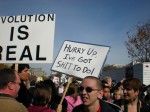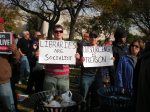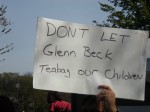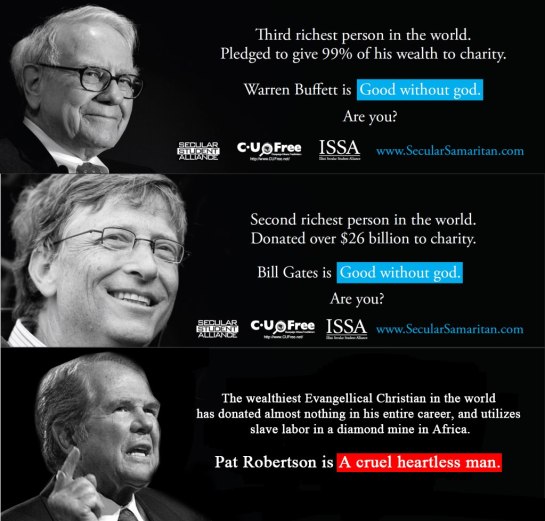
This little gem of a banner is posted on Highway 50 between Montrose and Delta, Colorado and it reminds me of what frustrates me so much in the United States. We can’t merely disagree with someone’s position, no, instead of having intelligent discourse about where we agree and disagree with a politician, we have to frame it in terms of patriotism, who’s the most Uh-mur-can, and then build arguments on faulty premises to the point that we can no longer even build sensible public discourse because our understanding of the world is so skewed and dogmatic that we lack the ability to be civil to one another. This problem is perpetuated by Americans’ lack of knowledge, our lack of engagement, and our lack of understanding of our own history.
In the fall of 2010 Jon Stewart of The Daily Show argued, “Take it down a notch America.” The “it”? Inflammatory rhetoric permeating our social and political discourse in the United States. Stewart’s argument was not new—President Clinton made this argument in the wake of the Oklahoma City Bombing (Mulloy, 2008). Journalist Thomas Friedman made the argument in 2009 upon reflecting on the summer of shouting at town hall meetings and the build up to President Obama’s school speech in September, 2009—an innocuous event that was the cause of much panic among some groups in the United States (Friedman, 2009). Arizona House Representative Gabrielle Giffords made this argument in response to pundit and former Alaska governor Sarah Palin’s use of violent metaphors like, ‘Don’t retreat-reload’ as well as Palin’s map of Democratic seats in the Tea Party’s sights—using the visual of a gun sight on her website to target Democratic seats in the House and Senate during the 2010 midterm elections (O’Donnell, 2011). And President Obama made this argument at the memorial service for those lost in the January 2011 shootings in Tucson, Arizona at Representative Gabrielle Gifford’s political gathering in a grocery store parking lot (Obama, 2011).
Resisting the urge to point fingers and elevating the quality of our discourse, as President Obama argued in his Tucson Memorial Speech, is simply not enough. While there may be nothing new about inflammatory discourse or even seemingly isolated acts of political violence in (Mulloy, 2008); we cannot ignore them nor can we dismiss them as merely the disconnected acts of violent individuals. To do so would be as irresponsible as letting fear-mongering and the witch hunts for antagonists in the story run rampant.
Pluralism and Political Violence
To understand the volatility of the environment in the United States since the fevered town hall meetings of 2009, we must more clearly understand the causes of political violence. The study of political violence is one whose foundations range from examining state-sponsored violence (e.g., Hitler’s targeting of Jews as a strategy to strengthen his political position) to violent protests from within. The present discussion is not meant to be a full-treatise on political violence, but rather a brief overview so that we may work from a common understanding of internal political violence in a post-9/11 era in the United States.
The United States is a pluralistic culture — we have people from many national, ethnic, religious, cultural, and social backgrounds. In pluralistic societies, tolerance only exists when the populace has the education and information to enable people to respect dissimilar views as well as the people who hold them. Manwell (2010) argues that a condition of political tolerance occurs when, despite differences, there is little threat to our core identity(ies), when we have a mass communication system that informs a populace, and when our individual and collective personalities are actually committed to the democratic values of individual rights and full citizen participation rather than authoritarian rule.
Greenberg (1975) argues that what we can measure in these moments of aggression are two distinctive manifestations of political violence: collective aggressive protests (e.g., riots and strong anti-government protests) as well as internal war (i.e., actions that result in deaths, armed conflict, and/or assassinations). Therefore, without tolerance, acts of aggression can become more likely because it is normalized and as a legitimate way of confronting those with whom we differ and disagree (Manwell, 2010). This is why we must discuss political violence in the context of the specific social and cultural conditions that increase the risk of acts of political violence (Coronil & Skurski, 1991). We must also be cautious not to limit our discussion of political violence to cases such as the Tucson shooting in 2011. Instead, we should also analyze cases where a violent environment failed to produce an act of political violence because we can learn just as much about the underlying social, historical, and collective identities the can lead to violence (Coronil & Skurski, 1991; Greenberg, 1975) as well as potential ways to minimize the risk of political violence.
If we understand that political violence is a response to threats to important social, cultural, and political identities, then we may better understand that political violence is not about economics, depravation, and the like that can create tension in an environment, but is about the successful integration of difference—with tangible examples of political violence emerging in places where depravation is marked by substantial political discord and group discrimination (Coronil & Skurski, 1991; Greenberg, 1975; Institute of Race Relations, 2010; Manwell, 2010; Pilat, 2009).
The conditions for political violence become ripe when at least one group believes they are not treated fairly on the basis of their identity specific despite political and social authorities espousing the equal incorporation of all (Greenberg, 1975). Manwell (2010) argues that when our worldviews are threatened—when what we know to be true is threatened, we experience a range of responses from contempt to physical aggression. She also points out that if this threat is physical, specifically if we fear physical harm, the severity of our response to the threat is greater. The fear response that Manwell (2010) suggested is in line with other research on emotional reactions to fear (Witte, 1996) finding that people will act in their own disinterest in order to justify their existing beliefs. The fear response itself need not be rational or even more objectively true to produce the threat (Manwell, 2010).
Inflammatory Rhetoric: Fuel for the Fire
Coronil and Skurksi (1991) argue that we must listen to what is being said in a culture at any given time because it allows us to understand the context, to understand competitive interpretations of meaning, and to understand meaning making. One important way to listen is to focus on messages from dominant media sources because the media are transformative sources of influence (Hutchison, 2010; Ismail, 2010; Manwell, 2010; Sosale, 2010). “Journalistic discourse can transform the symbolic space of media and culture industries into a signifier of nationalism, especially during times of war and crisis…” (Sosale, 2010 p. 224-225). Of course we know the news is not neutral—it is constructed from individual values, organizational values, public relations and advertising needs, and ideology (Ismail, 2010). Yet the media is important because how actions are reported—as grievances (i.e., bottom-up) or intuitional action (top-down) and whether those actions are reported as legitimate or not affects peoples beliefs about issues and actions (Chowdhury & Krebs, 2010).
Representations of a situation and its actors not only brings specific meaning to those events but through the visual and written/ spoken words viewers can actually experience the emotion of witnessing events first hand (Hutchison, 2010). Hutchison’s analysis on the politics of emotion and the international relations applications of reactions to traumatic events surrounding Australians’ reactions to the Bali bombings helps us to understand the very powerful role that the media can play in representing traumatic events. She suggests that today’s multi-media environment dramatizes events and that the media’s representation of events helps people to make sense and find meaning within communities touched by trauma. She points out the representations of traumatic events or perceived cultural trauma is powerful because the media representations can function to either attach or de-attach people to the events. The implication is simple, through selective media representations, events can be made more or less meaningful, create cultural identifications, and personal relevance by providing specific audiences with a context for understanding them.
Fox News: Building a Strong Community in a Post-9/11 World
At the risk of sounding like Rudy Giuliani’s failed 2008 presidential bid—9/11 changed us. This is not a post to talk about the often discussed social and cultural changes that have happened, but to talk about a post 9/11 world in the context of political violence. In the coverage of and since 9/11 two very strong themes emerged—nationalism and “America is under attack” (Manwell, 2010; Sosale, 2010). In fact, in our post 9/11 world, alternative explanations for events and views have often been dismissed as we have created and enforced disciplined dominant narratives (Ismail, 2010; Manwell, 2010). Sosale (2010) argues that the reproduction of themes of nationalism in everyday locales gives it strength, especially during times of crisis that “makes the media a fundamental cultural institution with a specific (national) identity” (p. 212).
During the quarter after 9/11, patriotism was the core message developed and communicated across the media (Sosale, 2010). Fox News took this theme very seriously and since then, Fox News has effectively built its brand to cater to conservatives (Sosale, 2010). They have been so effective in their messaging that they have not only influenced whether their key demographics vote, but who they vote for (Della Vigna & Kaplan, 2007). Fox News’s coverage of the war in Iraq is one substantial reason that Fox News gained viewers, experiencing a 300 percent increase in viewers at the beginning of the conflict (Corporation, 2003). Fox News’s growth continued spurred by events with strong partisan implications like the Republican National Committee meeting in 2004, the North Korean Missile Crisis, and the Israeli attacks on Lebanon (Journalism.org, 2005). Between 2007 and 2009 viewer evaluations of Fox News have increasingly demonstrated a growing partisan split in viewer satisfaction with 72 percent of Republicans compared to 43 percent of Democrats rating the network as “favorable” (Center, 2009).
Further, the Pew Research Center (2009) found that Fox News most strongly communicated a political ideology (i.e., conservative) of all networks in the United States, which probably accounts for their highest “unfavorable” rating at 25 percent. These ratings demonstrate that Fox News was not only appealing to self-identified Republicans and other conservatives, but also increasingly catering to them with information and editorials that support their worldviews. Unchecked by a genuine marketplace of ideas, increasingly partisan news coverage could become increasingly extreme over time, potentially fueling a contentious climate.
Because of Fox News’s emergent importance in the media landscape as well as their clearly partisan bias, we must ask the question of whether the rhetoric they employed leading up to President Obama’s school speech in 2009 employed the rhetoric of political violence as a strategy for selling their point. A grounded-theory methodology was used to analyze Fox News coverage of the issue.
Data Collection. In order to analyze Fox News, FoxNews.com was searched using the phrase “Obama school speech” and identified more than 100 multi-media (i.e., videos and printed stories on their website) stories for the two weeks leading up to President Obama’s speech of 2009 — a moment that built an incredible amount of tension in the United States yet did not cause political violence to emerge. Both news and opinion stories were included in the analysis in order to better understand Fox News’s total coverage of the speech.
Data Analysis. These data were analyzed using a comparison between the messages communicated in the Fox News coverage of the event with the model of the rhetoric of political violence identified for the American militia movement in the 1990s (see Mulloy, 2008).
Before 9/11, the American militia movement had grown substantially reacting to issues of abortion, gay rights, gun control, affirmative action, education, immigration, environmental politics, GATT, and NAFTA—all of which defined a basic belief that the United States was a nation in decline (Analysis, 2009; Mulloy, 2008). This contentious environment is very much in line with authors analyzing the conditions that create the potential for political violence (see Coronil & Skurski, 1991; Manwell, 2010; Pilat, 2009). Additionally, the American militia movement was based in deep cultural divides also necessary to foster an environment for political violence (Greenberg, 1975; Mulloy, 2008); and were fueled by critical events and cultural traumas (Coronil & Skurski, 1991; Hutchison, 2010) including the attack on the Branch Davidian compound, Ruby Ridge, and the Brady Bill[1] (Mulloy, 2008).
”Yet, what is particularly noteworthy about the emergence of contemporary political violence surrounding this movement was that the rhetoric of violence itself may have been less about violence as an end and more about capturing public attention, dramatizing issues, and building new political movements (Mulloy, 2008).”
Mulloy’s analysis suggests that an environment of political violence can exist in the United States without the necessary use of political violence by those invoking the rhetoric of political violence. Yet, when we also consider that the Unabomber committed acts of political violence and was a part of this socio-political environment, it is hard not to consider that the rhetoric of violence can correlate with acts of violence, thus suggesting that the overall risk for political violence in such an atmosphere is heightened.
Results. The central finding is that Fox News—in both its ‘traditional’ news and opinion coverage of President Obama’s speech employed the rhetoric of political violence in their partisan perspective against the speech. Much like Mulloy (2008) found with the American militia movement, it seems as though the Fox News coverage was predominantly about drawing attention to their perspective and appealing to their audience with messages that would resonate. The findings are discussed in terms of Mulloy’s three tenets of the rhetoric of political violence.
Drawing the line in the sand. The rhetoric of violence builds an argument that people should resist government that they view as tyrannical—basing much of their arguments in verbiage from the founding fathers (Mulloy, 2008). In his program on Fox News, Glenn Beck said of the school speech on September 2, 2009, “Stand guard America. Your republic is under attack.” When we examine what Mulloy (2008) found about the tactic of drawing the line in the sand, we find an argument that people should resist the government they view as tyrannical—basing much of their arguments in claims associated with the “founding fathers” of the United States. This strongly mirrors the Fox News coverage—in both the news and opinion segments of their coverage of Obama’s school speech. If we focus on the two core functions of this tactic—resistance and recruitment—we see resistance as a key feature of the advocacy against the President giving the speech. In their advocacy, Fox News painted a presidential school speech as something out of the ordinary that must have clear political objectives. In their coverage, we found rich appeals to preserving what America is meant to be by opposing this speech along with a sense of fighting the powerful government in an uphill battle to prevent the negative effects.
Additionally, we saw clear evidence of recruitment for their ideals in a number of ways. Mulloy (2008) argued that drawing the line in the sand was about getting noticed, getting headlines, and recruiting those who supported their perspective. As a major news network, Fox News certainly had the opportunity to get noticed; however, the speech’s saturated coverage is more telling. The speech was covered on all major programs airing on Fox News and made important parts of their feature programs (e.g., Glenn Beck’s, Bill O’Reilley’s, and Sean Hannity’s shows). And to some extent, they were successful in getting their uniform message taken seriously because we saw several schools across the south (e.g., Texas and Virginia) that refused to air the speech, despite students protesting the decisions.
Reconstructing patriotism. Mulloy (2008) found that patriotism was central to the militia’s heroic posturing and that the ultimate expression of patriotism is the willingness to die for country and ideals. Thus, a central feature in the rhetoric of political violence is to reconstruct the idea of patriotism to mark what would be patriotic and communicate a desire to fight for those values. Inherent in those appeals was a longing for ‘how things used to be’ (Mulloy, 2008).
Again, across both the “news” and “opinion” segments on Fox News, reconstructing patriotism was communicated strongly in the weeks leading up to the school speech. In particular, there was an elementary school performance from April 2009 replayed on virtually every program on Fox News. It consisted of children in one school performing a song in tribute to President Obama’s inauguration. The clip of school children singing “Barack Hussein Obama” was accompanied by comments painting him—both directly and indirectly—as a ‘Maoist’ supporting a ‘totalitarian’ vision for America and would be brainwashing our children in order to accomplish those goals. Fox News analysts and commentators pointed to the school children’s song from earlier that year as the warning sign and argued it must be opposed because it threatened the fundamental fabric of the United States. For example, on his show Sean Hannity made arguments opposing the speech and asking for people to join in opposition with statements like, “…for our children and for our future…” or “What will our children say?” or “Protect our countries values”.
Needle factories of free speech. The United States protects subversive speech, so the American militia movement was able to use our laws as a way to poke at our institutions. The critical component of this notion of ‘needle factories’ is that groups who use the rhetoric of political violence as a tactic focus on their ability to use subversive (to the government) speech and argue for specific action against the government that they believe threatens them (Mulloy, 2008). Couched in the assumption that the school children’s speech from the spring was evidence of a government agenda to brainwash and indoctrinate America’s children guests, pundits, and hosts of most news and opinion shows on Fox News called for action against the president and the school speech in order to protect our nation’s children—ranging from trying to prevent the speech from being shown, to keeping their kids home from school, to open protests against the president and speech. In fact, they made specific arguments that there was a credible threat from the government and suggested that we ‘must take action.’ Certainly, Fox News did not advocate directly for violence as a part of opposing the speech or their larger opposition narrative, but they used terms like ‘revolution’, ‘taking back our country’, and drew comparisons between armed conflicts and our present situation.
Did Fox News contributed to an environment that escalated the risk of political violence? Of course it did. Anytime that a dominant voice, especially one with the force behind it that Fox News has, is contributing to the risk of violence that voice’s impact must be managed and mitigated because of the risk in creating cultural trauma precipitating political violence during volatile times.
Strategies to Douse the Flame of Political Violence
Why does any of this matter? Why try to dissect and understand the socio-political environment surrounding a single speech in the United States? If we understand that we live under a threat of political violence surrounding American politics and a political environment of discontent—that just because we haven’t seen the spark to light the fire of political violence, that there is a genuine risk and we must listen to what is being said in our society (Coronil & Skurski, 1991). This risk was only reified as we watched in January 2011 as Representative Gabrielle Giffords was critically wounded in an attack that killed or wounded 12 other people. Failure to recognize critical risks in our environment and manage them as citizens and leaders is dangerous, often deadly.
The Risks of Divisiveness
In an era where the United States is grappling with its politics, its own beliefs about the relative value of pluralism, and managing issues of foreign and domestic importance, the more that the embers of anger are fanned with the rhetoric of political violence, the more risk we create of genuine political violence that goes beyond the Muslim taxi cab driver attacked in August, 2010 in response to the proposed Park 51 Muslim education and worship center. The more that our media not only gives voice to someone like Pastor Jones in Florida who proposed burning the Quran on September 11, 2010—sparking violent protests against the United States in Afghanistan and other predominantly Muslim countries—but creates people like him with the rhetoric of political violence—of ‘taking our country back’ and ‘standing up for the forgotten values of our forefathers,’ the greater the risk of increasing the frequency and severity of the political violence that we already experience.
With the strengthening of a radical right, our socio-political environment meets the criteria established earlier of an environment that would support political violence and we are beginning to see evidence of small acts of political violence within the United States for example, the attack of the Muslim cab driver and increased hate crimes against Muslims, gays, and Hispanics across the last several years (Investigation, 2010).
The Media’s Responsibility in the Atmosphere of Political Violence.
Given that we already know that journalistic discourse is transformative (Sosale, 2010) and that the media can act as agents of social control and influence (Hutchison, 2010; Ismail, 2010; Manwell, 2010; Sosale, 2010), to suggest that we live in an environment rife for political violence and that the media does not share a portion of the responsibility for that environment is naïve at best. This would not only apply to Fox News but to any media outlet as they report, editorialize, and interpret events for their viewers. However, given Fox News’ increasingly partisan coverage, their August 2010 substantial donation to the Republican Party (Benen, 2010), and use of the rhetoric of political violence as a communication strategy to further their ideological agenda, it seems clear that Fox News is the largest media contributor to an atmosphere of political violence in the United States because the people to whom they appeal—increasingly conservative demographics (Center, 2009; Della Vigna & Kaplan, 2007; Journalism.org, 2005)—strongly favor not only their type of coverage but their message as well.
By design or mere accident of outcome, the modern American news media seems to be a critical factor in predicting the risk for political violence. The media has the genuine potential to create trauma in their representation of events by invoking visceral emotions—as we saw evidenced in the Fox News coverage of the Obama school speech—using the rhetoric of political violence. Through their selective representations of events they gave social and emotional instructions to their viewers connecting single events with larger social issues as evidenced in their coverage of the school speech, linking the speech with their larger dominant narrative that the president is a threat to “American” identity and politics. Clearly naming and shaming news organizations promoting the rhetoric of political violence will not make temper their commentary because they are driven by what sells to their market.
However, it is possible that direct engagement might be useful for developing a movement against the rhetoric. Though often criticized for being “unpresidential” in his periodic engagement against the Fox News narrative, I believe that President Obama may have identified an effective strategy in managing the negative effects of media outlets behaving irresponsibly—engagement. By directly confronting the “risk” and indoctrination by simply releasing the speech and responding to the allegations, the White House virtually silenced the Fox News production machine. After the speech was released, Fox News did not silence their critiques, but the public fervor over the speech was mitigated.
The Positive Side
Developing a contextual understanding of the risk of political violence in a pluralistic society not only gives us mechanisms to evaluate the risk, but also clear opportunities to diffuse it. There were three characteristics of President Obama’s response to the school speech situation that helped to normalize the environment before the speech: direct engagement or response to the threat, transparency, and building a community identity. President Obama’s action to release the text of the speech the week ahead of the speech dispelled the major objections to the speech and showed the media hype to be barren fruit demonstrating both direct engagement and transparency. By showing that there was nothing to hide and nothing to fear, Fox News’s rhetoric of political violence was not able to sustain itself. The line they drew in the sand was blurred and the attention and recruitment to the cause was simply not sustainable. Moreover, once most people agreed that the message of violence was flawed, the appeals to patriotism and needling were no longer effective rhetorical appeals. Additionally, the message in the speech itself focused on the importance of education to our common future. By emphasizing common social and economic goals, the speech itself helped to mitigate the power and fervor in peoples’ previous feelings of fear and apprehension. Future research should explore these strategies to identify their strength and reliability.
Risk Management and Political Violence
Thought limited to one case, I believe that this analysis provides a model for future research and the more effective assessment and management of risk of political violence in pluralistic western democracies. Using the conditions perspective that we have developed, future research should evaluate and measure the ways in which threats to fundamental identities, critical events, and cultural trauma contribute to a heightened risk of political violence. Underlying this risk is the interaction of dominant media sources. If dominant media sources also employ the rhetoric of political violence, our analysis suggests that the risk for political violence is heightened because they may not only contribute to the cultural trauma but create trauma spawning political violence. Yet, we know very little about the attitudinal shifts that might occur amongst people directly because of the strategies of political violence in dominant media sources and indirectly as the core messages from the news entertainment industry filter into the blogosphere and social media outlets. This is a clear area for future research to be developed.
Moreover, the strategies for responding to and managing risks for political violence must be more specifically investigated. Previous research (e.g., Hutchinson, 2010) suggested that building community identity in the face of trauma can neutralize the risk for political violence, but the case of the Obama school speech also demonstrated that responding directly to threats and being transparent can help to neutralize the risk for political violence. If normalization of the environment is a critical component to managing the risk, then identifying engagement strategies and theories would be useful in helping to build a public sphere that is not only more able to identify credible threats of political violence but also respond to them effectively.
References
Analysis, O. o. I. a. (2009). Rightwing extremism: Current economic and political climate fueling resurgence of radicalization and recruitment. Retrieved from http://www.fas.org/irp/eprint/rightwing.pdf
Benen, S. (2010). News Corp’s GOP Donation Raises Eyebrows. Washington Monthly, (August 18). Retrieved from http://www.washingtonmonthly.com/archives/individual/2010_08/025255.php
Center, P. R. (Producer). (2009, April 5, 2010) Press accuracy rating hits two-decade low: Public evaluations of news media 1985-2009. Podcast retrieved from http://pewresearch.org/pubs/1341/press-accuracy-rating-hits-two-decade-low.
Chowdhury, A., & Krebs, R. R. (2010). Talking about terror: Counterterrorist campaigns and the logic of representation. European Journal of International Relations, 16(1), 125-150.
Coronil, F., & Skurski, J. (1991). Dismembering and remembering the nation: The semantics of political violence in Venezuela Comparative Studies in Society and History, 33(2), 288-337.
Corporation, B. B. (2003). War coverage lifts news corp. BBC News Retrieved Retrieved November 29, 2005, from http://news.bbc.co.uk/2/hi/business/3148015.stm
Della Vigna, S., & Kaplan, E. (2007). The Fox News effect: Media bias and voting. The Quarterly Journal of Economics, August, 1187-1234.
Friedman, T. (2009). Where did we go? . Retrieved April 19, 2010: http://www.nytimes.com/2009/09/30/opinion/30friedman.html
Greenberg, S. B. (1975). Social differentiation and political violence. The Journal of Conflict Resolution, 19(1), 161-184.
Hutchison, E. (2010). Trauma and the politics of emotions: Constituting identity, security, and community after the Bali bombing. International Relations, 24(1), 65-86.
Investigation, F. B. o. (2010). Uniform Crime Reports. Retrieved September 11, 2010: http://www.fbi.gov/ucr/ucr.htm
Ismail, A. (2010). Making sense of a barrier: U.S. news discourses on Israel’s dividing wall. Journal of Communication Inquiry, 34(1), 85-108.
Journalism.org (Producer). (2005, April 5, 2010) The state of the news media, 2005. Podcast retrieved from http://www.stateofthemedia.org/2005/narrative_cabletv_contentanalysis.asp?cat=2&media=5.
Manwell, L. A. (2010). In denial of Democracy: Social psychological implications for public discourse on state crimes against democracy post-9/11. American Behavioral Scientist, 53(6), 848-884.
Matthews, C. (Producer). (2007, September 11, 2010) ‘Hardball with Chris Matthews’ for March 23. Podcast retrieved from http://www.msnbc.msn.com/id/17798805.
Mulloy, D. J. (2008). “Liberty or Death”: Violence and the rhetoric of revolution in the American militia movement. Canadian Review of American Studies, 38(1), 119-145.
Obama, B. (2011, January 12). Text of President Obama’s Tucson Memorial Speech. CBS News. Retrieved January 16 from: http://www.cbsnews.com/8301-503544_162-20028366-503544.html.
O’Donnell, L., (2011, January 12) ‘The Last Word’ for January 12. Podcast retrieved from http://thelastword.msnbc.msn.com/.
Orjuela, C. (2010). The bullet in the living room: Linking security and development in a Colombo neighbourhood. Security Dialogue, 41(1), 99-120.
Pilat, J. F. (2009). The causes of terrorism. Journal of Organisational Transformation and Social Change, 6(2), 171-182.
Popper, N. (2005, February 25). Israeli newspaper brawl moving to the internet. The Jewish Daily Forward, from http://www.forward.com/articles/2979/
Sosale, S. (2010). Rallying around the flag: Journalistic constructions of a national mediascape in a global era. The International Communication Gazette, 72(3), 211-227.
Strauss, A., & Corbin, J. (1990). Basics of Qualitative Research: Grounded Theory Procedures and Techniques. Newbury Park: Sage.
Witte, K. (1996). Generating effective risk messages: How scary should your risk communication be? Communication Yearbook, 18, 229-254.
[1] The Brady Bill, enacted in 1993, requires background checks for any person purchasing a handgun in the United States.
Like this:
Be the first to like this.
![]() ), and much enthusiasm we headed to DC.
), and much enthusiasm we headed to DC.

